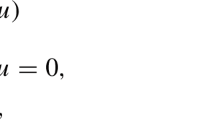Abstract
This paper addresses consistency and stability of W-methods up to order three for nonlinear ODE-constrained control problems with possible restrictions on the control. The analysis is based on the transformed adjoint system and the control uniqueness property. These methods can also be applied to large-scale PDE-constrained optimization, since they offer an efficient way to compute gradients of the discrete objective function.


Similar content being viewed by others
References
Bonnans, J.F., Laurent-Varin, J.: Computation of order conditions for symplectic partitioned Runge–Kutta schemes with application to optimal control. Numer. Math. 103, 1–10 (2006)
Büttner, M., Schmitt, B.A., Weiner, R.: W-methods with automatic partitioning by Krylov techniques for large stiff systems. SIAM J. Numer. Anal. 32, 260–284 (1995)
Dhamo, V., Tröltzsch, F.: Some aspects of reachability for parabolic boundary control problems with control constraints. Comput. Optim. Appl. 50, 75–110 (2011)
Hager, W.W.: Runge–Kutta methods in optimal control and the transformed adjoint system. Numer. Math. 87, 247–282 (2000)
Hager, W.W., Zhang, H.: A new active set algorithm for box constrained optimization. SIAM J. Optim. 17, 526–557 (2006)
Hager, W.W., Zhang, H.: Algorithm 851: CG_DESCENT, a conjugate gradient method with guaranteed descent. ACM Trans. Math. Softw. 32, 113–137 (2006)
Hairer, E., Wanner, G.: Solving Ordinary Differential Equations II, Stiff and Differential-Algebraic Equations, 2nd revised edn. Springer, Berlin (1996)
Jacobson, D.H., Mayne, D.Q.: Differential Dynamic Programming. American Elsevier Publishing, New York (1970)
Kammann, E.: Modellreduktion und Fehlerabschätzung bei parabolischen Optimalsteuerungsproblemen. Diploma thesis, Department of Mathematics, Technische Universität Berlin (2010)
Kaps, P., Rentrop, P.: Generalized Runge–Kutta methods of order four with stepsize control for stiff ordinary differential equations. Numer. Math. 33, 55–68 (1979)
Lang, J.: Adaptive Multilevel Solution of Nonlinear Parabolic PDE Systems. Theory, Algorithm and Applications. Lecture Notes in Computational Science and Engineering, vol. 16. Springer, Berlin (2000)
Murua, A.: On order conditions for partitioned symplectic methods. SIAM J. Numer. Anal. 34, 2204–2211 (1997)
Pulova, N.V.: Runge–Kutta Schemes in Control Constrained Optimal Control. Lecture Notes in Computer Science, LNCS, vol. 4818, pp. 358–365 (2008)
Rosenbrock, H.H.: Some general implicit processes for the numerical solution of differential equations. Comput. J. 5, 329–331 (1963)
Sandu, A.: On the Properties of Runge–Kutta Discrete Adjoints. Lecture Notes in Computer Science, LNCS, vol. 3394, pp. 550–557 (2006)
Sandu, A.: On consistency properties of discrete adjoint linear multistep methods. Report TR-07-40, Computer Science Department, Virginia Polytechnical Institute and State University (2007)
Schwartz, A., Polak, E.: Consistent approximations for optimal control problems based on Runge–Kutta integration. SIAM J. Control Optim. 34, 1235–1269 (1996)
Spellucci, P.: Donlp2-intv-dyn users guide. Version November 18, 2009
Spellucci, P.: A new technique for inconsistent QP problems in the SQP method. Math. Methods Oper. Res. 47, 355–400 (1998)
Spellucci, P.: An SQP method for general nonlinear programs using only equality constrained subproblems. Math. Program. 82, 413–448 (1998)
Steihaug, T., Wolfbrandt, A.: An attempt to avoid exact Jacobian and nonlinear equations in the numerical solution of stiff ordinary differential equations. Math. Comput. 33, 521–534 (1979)
Strehmel, K., Weiner, R.: Linear-implizite Runge–Kutta-Methoden und ihre Anwendungen. Teubner-Texte zur Mathematik, Bd. 127, Teubner (1992)
Verwer, J.G., Spee, E.J., Blom, J.G., Hundsdorfer, W.H.: A second order Rosenbrock method applied to photochemical dispersion problems. SIAM J. Sci. Comput. 20, 1456–1480 (1999)
Walther, A.: Automatic differentiation of explicit Runge–Kutta methods for optimal control. Comput. Optim. Appl. 36, 83–108 (2007)
Acknowledgments
J. Lang gratefully acknowledge the support of the DFG Priority Program 1253 entitled Optimization with Partial Differential Equations. We also want to thank Peter Spellucci for making his code DONLP2 available to us and for assisting us to find suitable coefficients for our ROS3WO method. I thank Jan for his long-time warm friendship and inspiring scientific collaboration. He will be greatly missed.
Author information
Authors and Affiliations
Corresponding author
Rights and permissions
About this article
Cite this article
Lang, J., Verwer, J.G. W-methods in optimal control. Numer. Math. 124, 337–360 (2013). https://doi.org/10.1007/s00211-013-0516-x
Received:
Revised:
Published:
Issue Date:
DOI: https://doi.org/10.1007/s00211-013-0516-x




